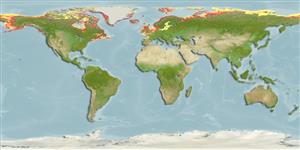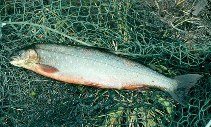Salvelinus alpinus (Linnaeus, 1758)
Arctic char
添加你自己的观测位置在 Fish Watcher
| Native range | All suitable habitat | Point map | Year 2050 |

|
| This map was computer-generated and has not yet been reviewed. |
| Salvelinus alpinus AquaMaps Data sources: GBIF OBIS |
Sweden country information
Common names:
Fjällröding, Röding
Occurrence: native
Salinity: freshwater
Abundance: | Ref:
Importance: | Ref:
Aquaculture: | Ref:
Regulations: | Ref:
Uses: no uses
Comments: Occurrence: Native and regular (Ref. 30402).
National Checklist: Sweden checklist - Fish
Country Information: https://www.cia.gov/library/publications/resources/the-world-factbook/geos/sw.html
National Fisheries Authority:
Occurrences: Occurrences Point map
Main Ref: Blanc, M., J.-L. Gaudet, P. Banarescu and J.-C. Hureau, 1971
National Database: Swedish Museum of Natural History
Occurrence: native
Salinity: freshwater
Abundance: | Ref:
Importance: | Ref:
Aquaculture: | Ref:
Regulations: | Ref:
Uses: no uses
Comments: Occurrence: Native and regular (Ref. 30402).
National Checklist: Sweden checklist - Fish
Country Information: https://www.cia.gov/library/publications/resources/the-world-factbook/geos/sw.html
National Fisheries Authority:
Occurrences: Occurrences Point map
Main Ref: Blanc, M., J.-L. Gaudet, P. Banarescu and J.-C. Hureau, 1971
National Database: Swedish Museum of Natural History
Common names from other countries
分类 / Names 俗名 | 同种异名 | Catalog of Fishes(属, 种) | ITIS | CoL | WoRMS | Cloffa
Teleostei > Salmoniformes (Salmons) > Salmonidae (Salmonids) > Salmoninae
Etymology: Salvelinus: Old name for char; it is the same root of german "saibling" = little salmon (Ref. 45335).
More on author: Linnaeus.
Etymology: Salvelinus: Old name for char; it is the same root of german "saibling" = little salmon (Ref. 45335).
More on author: Linnaeus.
Issue
The species Salvelinus aureolus Bean, 1887 is considered as valid in Eschmeyer (CofF ver. May 2011: Ref. 86870) following Fuller et al. (1999: Ref. 87253). Treated as synonym of Salvelinus alpinus oquassa by Qadi (1974: Ref. 87252); and probably a synonym of Salvelinus alpinus (see Nelson et al. 2004: Ref. 52299 for taxonomic issues). Please send references, or more studies are needed.
Environment: milieu / climate zone / depth range / distribution range 生态学
海洋; 淡水; 半咸淡水 底中水层性; 溯河洄游 (Ref. 51243); 深度上下限 0 - 70 m (Ref. 30578), usually 0 - 1 m (Ref. 101587). 溫帶; 4°C - 16°C (Ref. 2059); 82°N - 41°N, 180°W - 180°E (Ref. 117475)
分布 国家 | FAO区域 | 生态系 | 标本纪录 | Point map | 简介 | Faunafri
Europe and North America: Circumpolar (Ref. 86798). Iceland, Scandinavia, northern Russia (absent in rivers draining to Baltic and White Seas), Jan Mayen, Spitzberg, Kolguev, Bear and New Zemblia islands, northern Siberia, Alaska, Canada and Greenland; absent in the Alps (Ref. 59043). North America: coastal areas in Atlantic, Arctic and Pacific drainages from Newfoundland and Labrador in Canada to Alaska; south along Alantic Slope to Maine, USA (Ref. 86798). Landlocked populations in Quebec, Canada and in Maine and New Hampshire in USA (Ref. 7251).
歐洲: 北部大西洋向南至挪威南部, 也冰島與格陵蘭南部。 在英國北部,斯堪的那維亞半島,芬蘭與阿爾卑斯山脈中的孤立族群。 在美國的加拿大魁北克與緬因州與新罕布夏州的陸封族群.(參考文獻 7251)
歐洲: 北部大西洋向南至挪威南部, 也冰島與格陵蘭南部。 在英國北部,斯堪的那維亞半島,芬蘭與阿爾卑斯山脈中的孤立族群。 在美國的加拿大魁北克與緬因州與新罕布夏州的陸封族群.(參考文獻 7251)
Length at first maturity / 大小 / 重量 / 年龄
Maturity: Lm 60.0 range ? - ? cm
Max length : 107 cm TL 雄鱼/尚未辨别雌雄; (Ref. 40637); common length : 40.0 cm TL 雄鱼/尚未辨别雌雄; (Ref. 4779); 最大体重: 15.0 kg (Ref. 4779); 最大年龄: 40 年 (Ref. 46974)
Max length : 107 cm TL 雄鱼/尚未辨别雌雄; (Ref. 40637); common length : 40.0 cm TL 雄鱼/尚未辨别雌雄; (Ref. 4779); 最大体重: 15.0 kg (Ref. 4779); 最大年龄: 40 年 (Ref. 46974)
简单描述 检索表 | 型态特徵 | 形态测量图
背棘 (总数) : 4 - 5; 背的软条 (总数) : 8 - 16; 臀棘: 3 - 4; 臀鳍软条: 7 - 15; 脊椎骨: 62 - 68. Distinguished by the presence of 23 to 32 gill rakers, 37 to 75 pyloric caeca and, on the sides and back, pink to red spots, the largest of which are usually larger than the pupil of the eye (Ref. 27547). Lateral line curves slightly downward from the head (Ref. 27547). Pelvic fins with axillary process; caudal emarginate (Ref. 27547). Color highly variable, depending on location, time of year and degree of sexual development. In general, back is dark, usually rather brown but sometimes with a green cast; the sides are lighter, belly pale; sides and back are liberally sprinkled with pink to red spots, the largest spots along the lateral line usually larger than the pupil of the eye; forward edges of pectoral, pelvic and anal fins, and sometimes the caudal, with a narrow white margin; fins pale in young, dorsal and caudal dark in adults (Ref. 27547). Spawning adults, especially males, are brilliant orange-red to bright red on the ventral side and on the pectoral, pelvic and anal fins. Young have about 11 dark parr marks on each side (Ref. 27547). Caudal fin with 19 rays (Ref. 2196).
区别的特徵为那有 23 到 32个鳃耙,37 到 75个幽门的盲肠与, 侧边上与背面,粉红色到红色斑点, 最大的通常那是大于眼的瞳孔.(参考文献 27547) 侧线弯曲些微向下从头部.(参考文献 27547) 腹鳍有腋窝的羽翼突起; 尾部的边缘微凹的.(参考文献 27547) 被依据地点,年的时候与性发展的程度而定的彩色高变异的。 大体上, 背面颜色较深, 通常相当褐色但是有时有绿色的外貌; 侧边是颜色淡的, 腹面灰白的; 侧面与背面宽大地与粉红色到红色斑点一起洒,最大的斑点通常沿着侧线大于眼的瞳孔; 向前胸鳍的边缘, 腹鳍与臀鳍,而且有时尾鳍,具有一个狭窄的白色边缘; 鳍灰白的当幼鱼时, 背鳍与尾鳍黑的当成鱼时.(参考文献 27547) 产卵的成鱼, 雄性, 是色彩艳丽的尤其橘红色的到鲜红色在腹的侧边与胸鳍,腹鳍与臀鳍上。 幼鱼在两边上有大约 11个黑的幼鲑横带。 (参考文献 27547) 尾鳍有 19个鳍条。 (参考文献 2196)
区别的特徵为那有 23 到 32个鳃耙,37 到 75个幽门的盲肠与, 侧边上与背面,粉红色到红色斑点, 最大的通常那是大于眼的瞳孔.(参考文献 27547) 侧线弯曲些微向下从头部.(参考文献 27547) 腹鳍有腋窝的羽翼突起; 尾部的边缘微凹的.(参考文献 27547) 被依据地点,年的时候与性发展的程度而定的彩色高变异的。 大体上, 背面颜色较深, 通常相当褐色但是有时有绿色的外貌; 侧边是颜色淡的, 腹面灰白的; 侧面与背面宽大地与粉红色到红色斑点一起洒,最大的斑点通常沿着侧线大于眼的瞳孔; 向前胸鳍的边缘, 腹鳍与臀鳍,而且有时尾鳍,具有一个狭窄的白色边缘; 鳍灰白的当幼鱼时, 背鳍与尾鳍黑的当成鱼时.(参考文献 27547) 产卵的成鱼, 雄性, 是色彩艳丽的尤其橘红色的到鲜红色在腹的侧边与胸鳍,腹鳍与臀鳍上。 幼鱼在两边上有大约 11个黑的幼鲑横带。 (参考文献 27547) 尾鳍有 19个鳍条。 (参考文献 2196)
Nerito-pelagic (Ref. 58426). Occurs in the sea along coasts, estuaries, rivers, and lakes with cold, clear water (Ref. 59043). Found in deep runs and pools of medium to large rivers (Ref. 5723, 86798). Anadromous forms spend a considerable time of their lives at sea; non-migratory populations remain in lakes and rivers (Ref. 4779). Anadromous populations enter rivers to breed during fall and winter (Ref. 86798). Freshwater populations feed on planktonic crustaceans, amphipods, mollusks, insects and fishes (Ref. 4479). Anadromous individuals feed little in freshwater and never feed during migrations. Spawning usually takes place on pebble to stone bottom in lakes. Riverine stocks spawn in rivers with slow current (02.-0.8 m/s), but there are some riverine anadromous stocks (in Norway) which spawn yearly in fast-flowing waters of riffles (Ref. 59043). Extremely sensitive to water pollution (cold water and oxygen oriented) (Ref. 2163). Marketed fresh, smoked, canned (Ref. 27547), and frozen. Eaten sautéed, broiled, fried, microwaved and baked (Ref. 9988). Parasitized by tapeworm (Ref. 37032).
出现于中型到大型河川的深小支流与水潭 , 与湖。 (参考文献 5723) 溯河洄游产卵的造型在海上度过一个他们的生命的相当多时间; 非回游性族群逗留在湖与河。 (参考文献 4779) 淡水族群吃浮游性甲壳动物,片脚类动物,软件动物,昆虫与鱼。 (参考文献 4479) 非常地对水污染 (寒冷水与氧导向的) 敏感。 (参考文献 2163) 在市场上销售生鲜、烟熏, 将,装于罐头 (参考文献 27547) 与冷冻。 吃煎炒, 火烤了, 油炸了, 微波了而且烧烤了.(参考文献 9988) 被条虫寄生了。 (参考文献 37032)
出现于中型到大型河川的深小支流与水潭 , 与湖。 (参考文献 5723) 溯河洄游产卵的造型在海上度过一个他们的生命的相当多时间; 非回游性族群逗留在湖与河。 (参考文献 4779) 淡水族群吃浮游性甲壳动物,片脚类动物,软件动物,昆虫与鱼。 (参考文献 4479) 非常地对水污染 (寒冷水与氧导向的) 敏感。 (参考文献 2163) 在市场上销售生鲜、烟熏, 将,装于罐头 (参考文献 27547) 与冷冻。 吃煎炒, 火烤了, 油炸了, 微波了而且烧烤了.(参考文献 9988) 被条虫寄生了。 (参考文献 37032)
Life cycle and mating behavior 成熟度 | 繁殖 | 产卵场 | 卵 | 孕卵数 | 仔鱼
Males are generally territorial but when females start showing spawning behavior, males pair up with females and lose interest in their territories. Spawning takes place at almost any time of the day. A female invades a males territory and finds a suitable spot for a redd. Once a spot has been selected, she starts digging. While the female is digging, the male courts her by circling around her and then gliding along her side and quivering. When the redd is completed, the pair release egg and sperm. The pair then swim forward out of the nest, often still ejecting sex products. This may be repeated up to 5 times before the female begins to cover the eggs. The female then digs at the edge of the pit, covering the eggs and beginning the next redd (Ref. 27547). Males often mate with more than one female, taking the second mate after the first has exhausted the eggs. Sometimes, a female will mate successively with two or more males (Ref. 28968, 28969). Several days are usually required for females to deposit all their eggs (Ref. 27547).歐洲: 北部大西洋向南至挪威南部, 也冰島與格陵蘭南部。 在英國北部,斯堪的那維亞半島,芬蘭與阿爾卑斯山脈中的孤立族群。 在美國的加拿大魁北克與緬因州與新罕布夏州的陸封族群.(參考文獻 7251)
主要参考文献
Upload your references | 参考文献 | 合作者 | 合作者
Page, L.M. and B.M. Burr, 2011. A field guide to freshwater fishes of North America north of Mexico. Boston : Houghton Mifflin Harcourt, 663p. (Ref. 86798)
对人类的威胁
无害处的
人类利用
渔业: 低经济; 养殖: 商业性; 游钓鱼种: 是的
FAO(Aquaculture systems: 产生; 渔业: 产生; publication : search) | FishSource | 周边海洋
更多信息
Population dynamics
成长参数
Max. ages / sizes
Length-weight rel.
Length-length rel.
体长-频率
Mass conversion
入添量
丰度
成长参数
Max. ages / sizes
Length-weight rel.
Length-length rel.
体长-频率
Mass conversion
入添量
丰度
Anatomy
鳃区
Brain
Otolith
鳃区
Brain
Otolith
Physiology
Body composition
Nutrients
耗氧量
游泳类型
游泳速度
Visual pigments
Fish sound
Diseases & Parasites
Toxicity (LC50s)
Body composition
Nutrients
耗氧量
游泳类型
游泳速度
Visual pigments
Fish sound
Diseases & Parasites
Toxicity (LC50s)
工具
E-book | 野外调查 | 检索表 | 长度- 频率 Wizard | 生活- 历史的工具 | 分布图 | Classification Tree
| Catch-MSY |
特别资料
下载 XML
网络资源
Alien/Invasive Species database | Aquatic Commons | BHL | Cloffa | BOLDSystems | Websites from users | 核实 FishWatcher | CISTI | Catalog of Fishes(属, 种) | DiscoverLife | DORIS | ECOTOX | Faunafri | Fishtrace | GenBank(基因组, 核苷酸) | GloBI | GOBASE | | Google Books | Google Scholar | Google | IGFA World Record | MitoFish | 国家资料库 | Otolith Atlas of Taiwan Fishes | 公众的水族馆 | PubMed | Reef Life Survey | Scirus | SeaLifeBase | 树状分类阶层 | Wikipedia(转至, 搜寻) | World Records Freshwater Fishing | 动物学的记录
Estimates based on models
Preferred temperature (Ref. 115969): 0.1 - 9.7, mean 1.9 (based on 316 cells).
Phylogenetic diversity index (Ref. 82804): PD50 = 0.5000 [Uniqueness, from 0.5 = low to 2.0 = high].
Bayesian length-weight: a=0.00724 (0.00449 - 0.01169), b=3.03 (2.89 - 3.17), in cm Total Length, based on LWR estimates for this species & (Sub)family-body (Ref. 93245).
营养阶层 (Ref. 69278): 4.4 ±0.5 se; based on diet studies.
回复力 (Ref. 120179): 低的, 最小族群倍增时间4.5 - 14 年 (tm=7-10; tmax=24; Fec=400).
Prior r = 0.24, 95% CL = 0.16 - 0.35, Based on 2 full stock assessments.
Fishing Vulnerability (Ref. 59153): High to very high vulnerability (70 of 100).
Climate Vulnerability (Ref. 125649): High to very high vulnerability (71 of 100).




